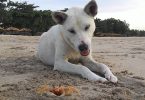“Give a dog a bone, leave a dog alone.” It’s one of the most common pet clichés. If dogs’ prayers were answered, bones would rain from the sky. There isn’t much that makes a dog happier than a nice bone to chew on. While you can buy all sorts of bones at a pet store for your dog to chew on, you might be wondering if it’s alright to give your dog a lamb bone. Maybe you just had a delicious dinner at the steak house and want to bring back a little treat for your best buddy, but you aren’t sure whether it’s safe to give him or her that lamb bone.
Can dogs eat lamb bones?
The short answer is yes. However there are certain things you should know before feeding lamb bones to your furry friend.
Why dogs love bones?
It’s not a secret that dogs absolutely love bones. Any type of bone, whether from steak, lamb, or chicken, your dog will be inclined to chew it up and eat it. However, it all depends on the type of bone and whether it has been cooked or not.
Dogs love bones because they taste great for them, as bones are an animal tissue, and dogs are naturally carnivorous. Dogs like to eat raw bones in order to give their jaw some exercise and clean their gnashers. They will also actually eat it too.
Dogs naturally have the need to chew, and bones provide the perfect relief for this need. Puppies especially are prone to excessive chewing – shoes, paper, furniture and myriad other items. Like human babies, puppies improve their knowledge of their surroundings with their mouths, as it is the easiest way to feel and taste things for them. Also, like babies, puppies go through a teething process, and chewing and gnawing on a bone helps with their pain of teething.
Older dogs will also want to chew. Dogs that live in the wild are used to catching and killing their prey, as well as eating carrion, so they are more used to gnawing and chewing bones than regular dogs that eat kibble. Hence, domesticated dogs that eat kibble still have this natural urge to chew, give their jaws a workout and scrub their teeth, and bones provide the perfect outlet to do so. Since bones are a lot tastier than many other items that dogs commonly chew, dogs love them.
Bones are also excellent ways of keeping a dog’s teeth and gums healthy, allowing them to exercise and stimulate their gums while passively cleaning their teeth. This is one of the better reasons to give your dog a bone, not to mention the fact that you will save hundreds and hundreds of dollars that might otherwise be spent on dental care.
In addition to chewing and jaw exercise, bones have marrow, which dogs find quite irresistible. Bone marrow within raw bones are rich in nutrients, such as glucosamine and chondroitin, both of which are essential for healthy bones and joints.
Lamb bones need to be raw
So while it may be common to give your dog a beef bone, dog owners might be wondering if it is alright to feed a dog a lamb bone. They should be happy to know that it is okay to give a dog a lamb bone, but it HAS to be raw, as cooked bones can be harmful.
Normal, healthy bones are not brittle like cooked bones are. If you have ever handled both cooked and raw bones, you can tell that cooked bones are lighter, weaker, and more brittle. Cooked bones become hard, easy to crack, and easily splintered, making a cooked bone a potential health hazard for dogs if eaten and swallowed. Raw bones, on the other hand, have an almost spongy and chewy texture to them. Dogs can safely chew, crack, and break raw bones down with their teeth, swallow them, and have no problem digesting them.
Lamb bones splinter easily when cooked
If you feed your dog a cooked lamb bone, there are many potential health hazards that can affect your dog. Splintered bones are sharp and can harm your dog in several different ways. The splintered bones can cut a dog’s gums, tongue, and roof of mouth, causing great pain for the dog and making it quite difficult and painful to eat their food. If bone splinters are swallowed, the splinters could potentially get lodged in the throat, which could potentially cause damage to the esophagus.
The biggest problem with feeding a dog a cooked lamb bone, however, is the potential for the bone splinters to cause damage to the stomach or intestine. Both organs are full of bacteria that, if cut by a bone splinter and let loose into the dog’s body, can potentially cause death. Infections from a perforated stomach or intestine a quick, painful, and usually deadly.
Conclusion
So, if you want to give your best animal friend a lamb bone, be SURE that it is completely raw. There will be no danger posed to your pup, and he or she will benefit in many ways. Their jaws can get exercise, they can clean their teeth, and they get to chew on something delicious!
References:
http://www.petmd.com/blogs/fullyvetted/2010/april/no_dog_bones-7313









Leave a Comment